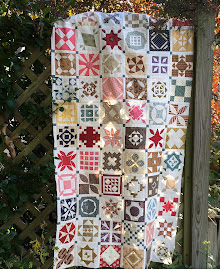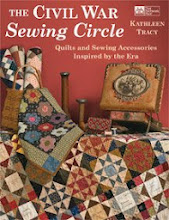I'm feeling patriotic, or at least I was yesterday when I took advantage of my right to vote. Someone commented on the blog about the small part of my Lincoln's Platform quilt I showed and asked to see the whole quilt. It's one of my favorite quilts from Remembering Adelia.
Lincoln's political platform during the 1860 presidential election (and also his bid for re-election in 1864) called for an end to slavery and a reuniting of the country that was torn apart at the time.
Next year marks the 150th anniversary of the beginning of the Civil War in the United States. Adelia's diary portrays some of the thoughts that were going through women's minds at that time and I tried to include some quilts in the book that may have been popular around the time of the war. I wrote my next book, The Civil War Sewing Circle, with that in the back of my mind and it was fun to immerse myself in some of the research about women and the impact that their quilting had on the war. I've been influenced by Lincoln's legacy in making a few of my little quilts before and though I am not a quilt historian, it's always fascinating to find out more about the connection between quilt pattern names and the history behind them.
From the Library of Congress
Most of you know that there has been an abundance of stories written about quilting and the Civil War, and for years we loved to imagine women frantically sewing quilts with secrets hidden within, helping slaves escape. Truth is, we now know that these stories are considered myths that have been for the most part disputed by historians.
From the Library of Congress
For instance, according to myths, the Underground Railroad or Jacob's Ladder quilt pattern, with its light and dark contrasting squares set in an ascending formation, was said to point slaves to a safe path to freedom.
From my book American Doll Quilts
The Log Cabin quilt has its own mystique surrounding it. According to stories, safe houses for escaping slaves were supposedly those that displayed a Log Cabin quilt with a black center and when these quilts were hung in a window or on a clothesline, slaves could be assured of a hiding place on their journey. Quilt historians say that the first documented Log Cabin quilt was dated after the Civil War and could not have been used during the time of the conflict and was probably named as a tribute to President Lincoln's boyhood home (a log cabin) or as a symbol of the Union's loyalty to him.
Thus, while our imaginations love these stories of quilts and slaves, historians tell us that there is simply no evidence that quilts played a role in helping slaves escape to freedom. We now know that the stories are probably fiction and many of the blocks were renamed later, after the war. In actuality, instead of sewing codes into cloth, thousands of women were sewing frantically in their sewing circles to make bedding and clothing for the many soldiers who desperately needed these items.
Whatever history tells us, and whatever disappointment we might feel at finding out the truth about the actual role that quilts played, it shouldn't discourage us from making quilts like these with names associated with the war as a tribute to Lincoln, the war, or the men and women who played such an important role in this stage of American history.

















5 comments:
Loved reading your post today. So much history in quilts, no matter what their age, they each have their own history to tell. That's why it is so important to put labels on our quilts. By the way, I need to go make some labels for some of my own quilts {grins}. Thanks for sharing your love of quilting with us and giving us such neat patterns and books to make our own little pieces of history! HUGS... and stitches
Lincoln wasn't considered viable in 1864. It had been decades since Jackson's second term. The dem attack machine was effective. It took Sherman's success and the chasing of military votes to make it happen. Imagine an age when the military were encouraged to vote (unlike today). Thank goodness we didn't end up with McClellan or Fremont.
Thank you so much for mentioning the UR myths. It does get a bit tiresome to see all these white women online inferring my ancestors were dumb pickaninnies who relied on cotton blankets to supply their good sense. With or without reading and writing, they were not brain damaged and had a great deal more survival sense than their white counterparts. Now a blanket honoring the UR is another matter entirely. Honor away, ladies!
In our defense, I truly doubt that many white quilters really think that they were "dumb pickaninnies" for supposedly relying on quilts for paths to freedom. The Underground Railroad succeeded because free blacks, escaped slaves AND white people with consciences all worked together. Slaves attempting escape had to rely on their own instincts and resources for sure but it must have been so treacherous that additional help was necessary. There is much misinformation out there and we need "truth tellers" backed up by research to set the record straight.
i do love reading about the history of quilts and i also love getting caught up in the 'romance' of the day-to-day lives of the pioneer women. i was totally transported to the another time and place whilst reading Adelia's diary..it was delightful!
btw i LOVE all the little quilts in this post..adorable! x
I just love reading your stories about the history of quilts relating to the Civil War. Your quilts are adorable and I love the fabric choices you make putting them together.
Oh by the way, my Civil War Sewing Circle Pattern came today. I love the baskets and look forward to making this one too. Your pattern books are beautiful. You sure have put a lot of work into each one. Thank you so much.
Post a Comment